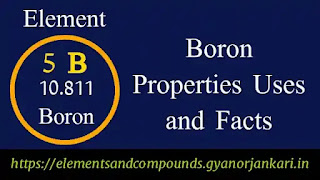Properties Uses and Facts about Boron
What is Boron
Boron is classified as a metalloid, and chemically it is an element.
Metalloids are elements that show properties of both metals and non-metals.
The density of boron is 2.37 grams per cubic centimeter. Boron has the
symbol B, atomic number 5, and atomic mass 10.811 amu. Boron's atom has 5
electrons, 5 protons, 6 neutrons and 2 energy levels. In the
Periodic Table, Boron is located in Group 13, Period 2 and Block P. Boron is found in the
solid state at room temperature, its melting point is 2075 °C (3767 °F), and
its boiling point is 4000 °C (7232 °F).
Boron was discovered by the French chemists Joseph-Louis Gay-Lussac and
Louis-Jacques Thenard and the English chemist Sir Humphry Davy in
1808.
Properties of Boron
- Boron is found in two forms (Allotropes), Amorphous Boron and Crystalline Boron.
- Amorphous boron has molecules linked together randomly, so it is found in the form of powder, its color is dark brown.
- Crystalline Boron is a black colored crystalline material which is extremely hard and brittle.
- Crystalline boron is chemically almost inert as compared to amorphous boron.
- When exposed to oxygen in the air, a thin layer of boron trioxide (B2O3) is formed over the boron, which prevents further reaction with oxygen.
- Boron does not normally react with acids, but it reacts with hot nitric acid (HNO3) and hot sulfuric acid (H2SO4).
- Boron dissolves in molten metals.
- Boron is a poor conductor of electricity at room temperature, whereas at high temperatures boron is a good conductor of electricity like the metals.
- Boron is chemically less reactive, but it is not found in pure state in nature.
Uses of Boron
- Boron is used to give green light in firecrackers.
- Boron is used in the production of ceramics and borosilicate glasses, which are hard and heat resistant. It is also used in the manufacture of fiberglass.
- Amorphous boron is used as a rocket fuel igniter.
- The isotope of boron, boron-10, has the ability to absorb neutrons, so it is used in nuclear reactors.
- Boron-10 is also used in neutron detection equipment.
- Boric acid, borax, and boric oxide are compounds of boron that are used in eye drops, washing powders, and mild antiseptics.
- Borax is also used in food preservation.
- Boron filament is used in the aerospace industry because it is light in weight and extremely strong.
- Boron, iron and niobidium alloys are used to make very powerful magnets.
- Boron is used in the manufacture of semiconductors.
Interesting facts about Boron
- Boron is the 37th most abundant element in the Earth's crust.
- We get about 2 mg of boron daily through food, and about 18 mg of boron is present in our body.
- Boron is an essential nutrient for plants.
- Possibilities of treatment of Arthritis with Boron are being explored by the scientists.
Detailed Information on Some other Elements
- Sodium Metal | Properties | Uses | Facts
- Helium Gas | Properties | Uses | Facts
- Neon Gas | Properties | Uses | Facts
- Argon Gas | Properties | Uses | Facts
- Xenon Gas | Properties | Uses | Facts
- Krypton Gas | Properties | Uses | Facts
- Radon Gas | Properties | Uses | Facts
- Potassium | Properties | Uses | Facts
- Beryllium | Properties | Uses | Facts
- Magnesium | Properties | Uses | Facts
- Calcium | Properties | Uses | Facts
- Strontium Metal | Properties | Uses | Facts
- Barium Element | Properties | Uses | Facts
- Zinc Metal | Properties | Uses | Facts
- Cobalt Metal | Properties | Uses | Facts
- Chromium Metal | Properties | Uses | Facts
- Manganese Metal | Properties | Uses | Facts
- Vanadium | Properties | Uses | Facts
- Scandium | Properties | Uses | Facts
- Yttrium | Properties | Uses | and Facts
- Fluorine Gas | Properties | Uses | and Facts
- Chlorine Gas | Properties | Uses | and Facts
- Bromine | Properties | Uses | and Facts
- Iodine | Properties | Uses | and Facts
- Nitrogen | Properties | Uses | and Facts
- Carbon | Properties | Uses | and Facts







No comments:
Post a Comment